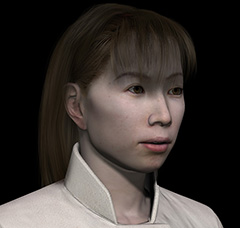In the ongoing evolution of computer games towards a mature art form, we see many blips on the radar that fade away after some time. But there is one game that never goes away. Silent Hill 2. There’s something about that game that is so intensely inspiring, beautiful and moving that it continues to give hope to everyone on this path.
By creating some of the most important artistic aspects of both Silent Hill 1 and 2, Takayoshi Sato has been one of very few people within the games industry that have been of major importance to our own activity at Tale of Tales. His work demonstrated that there was room in the games industry for subtle art work and complex stories, something which is easy to forget in the ongoing onslaught of infantile entertainment that the industry continues to excrete. Mr. Sato approaches the medium as an art form. A medium that allows us to talk about human stories in a sophisticated and beautiful way. And he does this with impressive commercial success to boot.
In the mean time Mr. Sato has moved to the USA and worked on several AAA titles for major companies. Yet none of these were able surpass the effect that Silent Hill 2 had in our minds. So when we heard that Takayoshi Sato switched industries and is now designing serious games, our curiosity was tickled…
(from The Making Of Silent Hill 2)
Silent Hill
Tale of Tales (ToT): Silent Hill is still going. There’s been a Silent Hill 3, 4 and soon 5, all without your involvement. Silent Hill 3 was a lot less complex than Silent Hill 2. And Silent Hill 4 was completely different. How do you feel about the evolution in the series without you?
Takayoshi Sato (TS): It’s normal that a change of team changes the feel of the product. That’s what happened with Silent Hill 3 & 4.
ToT: What did you think of the Silent Hill movie?
TS: I like many of its visual elements. And their use of the exact same camera shots and lighting in several scenes as in my cinematics, made me smile nostalgically. But as a whole, the movie is a different thing. Seeing it was like being reunited with your child for the first time in 10 years and being surprised by how different it had become. I had a lot more ideas for game gimmicks and story elements for the realm of Silent Hill, but the movie took a different path. You can not control what your children grow into once they leave home.
“Hit products tend to be born like this: simply as the result of someone’s creative pursuit.”
ToT: Silent Hill 2 is one of the few games that continues to be used as an example of the direction that games could take if you treat them as an artistic entertainment medium, rather than just fun toys to play with. What do you think makes that game so different? And do you feel that the games industry has evolved much in this respect since Silent Hill 2 (published in 2001)?
TS: Usually there are many people to satisfy in game development. When there’s too many cooks in the kitchen, you get products that lack focus, have no edge and are simply boring. But Silent Hill 1 became very successful and I got three awards for it. That allowed me to pursue my own creative vision. Now I realize that that was a very rare situation. But it offered me a chance to prove that a highly artistic project can sell without any particular marketing elements. I am more interested in profound artwork that remains in people’s hearts for a long time than quick money-raking products. I thought that if Silent Hill 2 remained a masterpiece for a long time, its profits would exceed major products eventually. Hit products tend to be born like this: simply as the result of someone’s creative pursuit.
Art in the games industry
ToT: You were a trained as a fine artist. How do you feel about the place of artists (and art) in the games industry?

In Mr. Sato’s hands, 3D modeling becomes as expressive and nuanced as traditional sculpture and painting.
TS: I was taught that only works that change the definition of the world should be called Art. I studied contemporary philosophy, literature and cultural history to fulfill that mission. Art was a very respectable thing to me. Only people who create artworks that redefine the world should be called Artists. The word was too honorable to simply call yourself an artist. That was my definition of Art and Artist: very very honorable things. Even when I entered the commercial world, I was still trying to create Art using digital interactive media.
“Brainstorming with large numbers of people may give you great ideas, but never leads to depth and perfect balance.”
But lately, artists are expected to be “professionals”. Their position in the industry seems to have become more that of a person who simply executes a plan. And when something goes wrong, the artists are blamed. I see this happening a lot more lately than before. And it makes me very sad.
ToT: Do you think there is still a chance for games to develop into a real artistic medium?
TS: Yes. If sufficient time and funding is funneled into the right person. So that there is enough time to contemplate. Brainstorming with large numbers of people may give you great ideas, but never leads to depth and perfect balance.
ToT: What would be the ideal situation for you to create a game?
TS: Three years of part preproduction and part development, starting small and getting bigger as the project progresses. No executives constantly changing the project, so that I can direct throughout the course of the project.
And even if I’m not in the directing position, it’s really important that everybody knows who the decision maker is and how the “chain of command” is structured. That keeps the project focused.
ToT: How important were technical limitations for the creation of the look and feel of Silent Hill 2?
TS: They were not important. Better technology is always welcome. The key is what you spend all the tech, energy and resources on. You need to select this carefully otherwise the product will look like some kind of carnival.
Serious games
ToT: You recently decided to go and work for a company that produces serious games (training simulations and the like). This strikes me as an odd decision for somebody who has had such an important impact on the fictional and artistic side of the medium. Could you tell us a bit about what motivated the change?
TS: I feel that games are being standardized into only a few formats lately: FPS, RTS, MMO, 3rd Person Action and Sports. There’s a tendency to create the same games over and over with only a visual upgrade. And the only thing artists are supposed to do is “be professional” and gift wrap the same game elements with a pretty new skin.
“Since serious games are in their infancy, I thought it might be a great place to seek future possibilities.”
Then I encountered serious games. Despite of the downsides -small budgets, clients to satisfy, etc- serious games allow us to convey social messages, for instance. There hasn’t been an opportunity for deep story telling yet. But even making a game about behavior changes in the context of social problems, seems a little more creative than just making more and more weapon concepts. I find it hard to like games that only provide a “kill kill kill” experience. Since serious games are in their infancy, I thought it might be a great place to seek future possibilities. I hope that very interesting things will happen down the road.

Even in recent artwork for serious games, Mr. Sato’s genius still shines through.
Also, small budgets sometimes make production rough. But in a way, I am enjoying the combination of providing Art Direction and getting my hands dirty doing actual art work. This sort of thing has been lost giant game production.
Future plans
ToT: Have you ever considered going independent? Starting up a project on your own, a smaller one perhaps with a smaller budget? Perhaps financed through arts funding?
“I believe that there will be a moment and a place for ambitious artistic vision in game production.”
TS: I haven’t thought about it realistically. As long as someone is paying for you, there doesn’t seem to be much difference between being employed and being funded.
ToT: The American games industry hasn’t succeeeded in making your talents flourish. Have you ever considered trying your luck in Europe? Or returning to Japan?
TS: I still like what I do. Art Directing, Creating a look and feel. I made the choice of going out into the world instead of staying in a privileged position in Japan for many reasons. But I believe that there will be a moment and a place for ambitious artistic vision in game production. That’s what I want, whether it’s in the USA or Japan or Europe. Silent Hill was most appreciated in Europe. So perhaps Europe would welcome me as well.
This interview was conducted via email by Michaël Samyn over the course of several months. Some of the answers of Mr. Sato have been rephrased for clarity.
More pictures and information about Takayoshi Sato can be found on his personal website.


Wooooooooow! fantastic! Another hero of mine being interviewed by other heros of mine!
Is an extremely interesting interview, not only because that Takayoshi was an importante part of the best game i’ve ever played so far (Silent Hill 2), but because I never heard about “serious games” :O
Takayoshi, you’ll be forever in the glory! m/
Great work, guys. You did a great interview
great interview!
thanks for doing those with such interesting characters as Sato-San.
I remember my dad looking at the game’s manual and telling me that ALLLLL the CG in the game was made by ONE guy. i was blown away. then i played 2 of the best games ever and became a huge fan of both.
i constantly site Silent Hill 2 to be just about the only truly mature game ever.
Very interesting interview and I feel the same way. It does seem like there’s a formula that all developers are using now; lately I’ve felt that the gaming industry is smothering the market with only a handful of types of games. Luckly, there’s a few diamonds in the rough out there.
I personally felt that Silent Hill 2 was the best in the series and it’s no surprise as to why. Yes, Sato, Silent Hill 2 will remain in our hearts for years to come.
I wish him luck with his serious games.
Takayoshi Sato is such a wonderful man who clearly wants to push games to their limits artistically. It’s refreshing to see that he still enjoys what he does.
Perhaps after I receive my B.F.A. for game development I could have the honors of working under a genius such as him.
Hopefully we’ll see the blend between emotional masterpieces and physio-kinetic realism that is only possible in serious games…
… seriously!
very cool. he seems like an interesting character.
Thanks so much for this interview — all the other Takayoshi Sato interviews seem to concentrate on the technical and operational side of things rather than artistic philosophy.